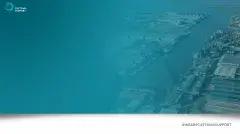The history of the Port of Antwerp
Although the modern-day Port of Antwerp was established in 1811 with the construction of the Bonaparte Dock, the area has been used as a port since the second century. It was given its name using a combination of “anda” and “werpum”, which translates into “at wharf”.
In its early life, the port was used for small exports of wine to England. However, the main use was as a military position to protect from invaders coming down the river Scheldt.
The first significant period of growth for Antwerp was during the development of the textile industry in the 14th century when English wool became a popular import for Europe.
At the turn of the 16th century, the Scheldt Estuary was reshaped and expanded by extreme weather, which allowed larger, long-distance, sea-worthy vessels to access the port. This was the catalyst that created the Port of Antwerp’s golden age.
By the mid-1500s, the port had 10 wharves and eight docks.
In 1558, the area was conquered by Spain and divided into North Netherland (today, The Netherlands) and South Netherland (today, Belgium). Access to the port was restricted, and commercial activity was starved until alternative routes were found through Ghent.
Following the construction of the Bonaparte Dock in 1811, the Port of Antwerp underwent significant growth. Trade with Africa, America, and Asia began routing through the area, and companies from all over Europe set up entities in the region. Then, the first railway line in Belgium was built to connect the port to the Port of Cologne, and the economic boom continued as exports increased six-fold.
In the late 19th and early 20th centuries, the port was renovated. The river Scheldt quays were straightened and five new docks were added. This continued over the next century, and the port covered over 36 kilometres of quays by the 1930s.
Grains, coal, chemicals, and refrigerated goods were all traded through the port, which handled over 26 million tonnes of cargo per annum.
The Port of Antwerp was one of the only ports not to be destroyed in World War II and continued expansion in the 1950s.
In 1967, the Atlantic Span (the world’s first containership) docked at Antwerp. Containerised cargoes boomed, with over one million tonnes passing through Antwerp in 1969.
Today, the Port of Antwerp handles over 240 million tonnes of freight every year.
Customs Support Belgium
With the Port of Antwerp being such a key location for European trade, it naturally appealed to us to be the home of the new Customs Support office for Belgium. We moved in on the 19th of June.
Customs Support Belgium is one of our branches that is leading the way with digitalisation in customs, following the acquisition of Portmade.
Thanks to cutting-edge technology, our 66-strong team of specialists can complete well over one million declarations in a year without sacrificing quality of service.
Moreover, the range of expertise found at Customs Support Belgium means we can provide you with a full portfolio of customs services, including but not limited to:
- Import and export clearance.
- Excise processing.
- Customs consultancy.
- Bonded warehouse inventory.
- Duty management functions such as Inward Processing Relief.
- Transit documents.
- Digital interface and integration setup.
Customs Support is not only the largest provider of customs services in Belgium but also one of the only companies that operate 24/7, meaning you can contact us for assistance at any time.
Did you know?
- Although Belgium has three official languages (Dutch, French, and German), the language of the Antwerp province is Dutch.
- Antwerp hosted the first Summer Olympic Games after World War I, in 1920.
- Antwerp is also known as “The Capital of Diamonds” because between 80% and 90% of the global trade of rough diamonds, and 50% of cut diamonds, travel through each year. Antwerp’s diamond district covers over one kilometre of the street and hosts huge showrooms and workshops where you can see gems displayed and processed.
- The Boerentoren high rise, standing 26 stories high, was built in 1932 and is Europe’s oldest skyscraper.
- The Antwerp Royal Academy of Fine Arts is one of the oldest and most important fashion schools in Europe.
Need Customs Support in Antwerp?
Customs Support Belgium provide a full range of customs services across the EU and the UK. Contact us for more information.














